2014 MERCEDES-BENZ B-CLASS SPORTS warning light
[x] Cancel search: warning lightPage 58 of 360
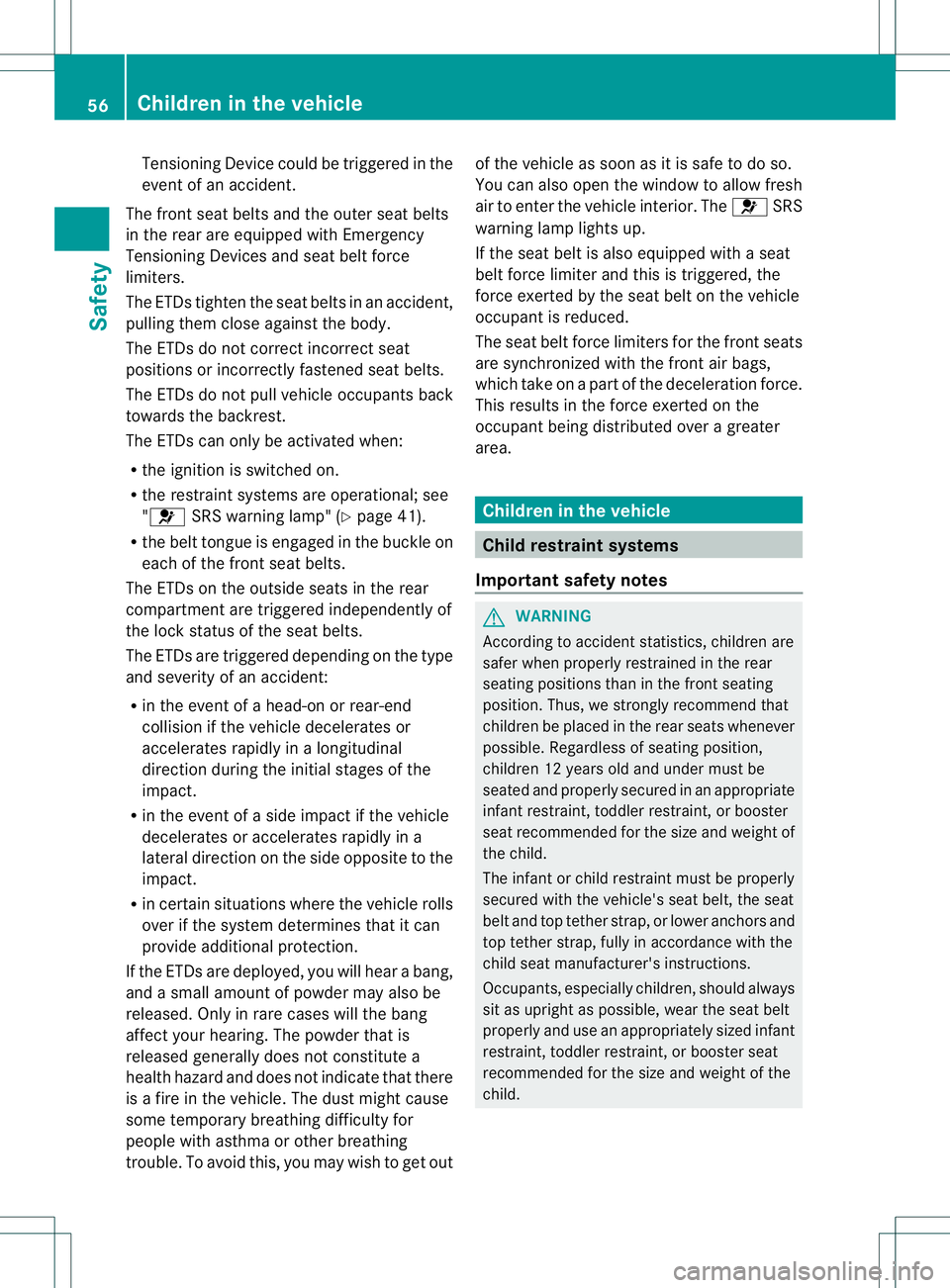
Tensionin
gDevice could be triggered in the
event of an accident.
The fronts eat belts and the outer seat belts
in the rear are equipped with Emergency
Tensioning Devices and seat belt force
limiters.
The ETDst ighten the seat belts in an accident,
pulling them close against the body.
The ETDsdon ot correct incorrect seat
position sorincorrectly fastened seat belts.
The ETDsdon ot pull vehicle occupants back
towards the backrest.
The ETDsc an only be activated when:
R the ignition is switched on.
R the restraint systems are operational; see
"0021 SRS warning lamp" (Y page 41).
R the belt tongue is engaged in the buckle on
each of the fron tseat belts.
The ETDsont he outside seats in the rear
compartment are triggered independently of
the lock status of the seat belts.
The ETDsa re triggered depending on the type
and severit yofanaccident:
R in the event of ahead-on or rear-end
collision if the vehicle decelerates or
accelerates rapidly in alongitudinal
direction during the initial stages of the
impact.
R in the event of aside impact if the vehicle
decelerates or accelerates rapidly in a
lateral direction on the side opposite to the
impact.
R in certain situation swhere the vehicle rolls
over if the system determines that it can
provide additional protection.
If the ETDsa re deployed, you will hear abang,
and asmall amount of powder may also be
released. Only in rare cases will the bang
affect your hearing. The powder that is
released generally does not constitute a
health hazard and does not indicat ethat there
is af ire in the vehicle. The dust might cause
some temporary breathin gdifficult yfor
people with asthma or other breathing
trouble. To avoid this, you may wish to get out of the vehicle as soon as it is safe to do so.
You can also open the window to allow fresh
air to enter the vehicle interior. The
0021SRS
warning lamp lights up.
If the seat belt is also equipped with aseat
belt forc elimiter and this is triggered, the
forc eexerted by the seat belt on the vehicle
occupant is reduced.
The seat belt force limiters for the front seats
are synchronized with the front air bags,
which take on apart of the deceleration force.
This results in the force exerted on the
occupant being distributed over agreater
area. Children in the vehicle
Child restraint systems
Important safety notes G
WARNING
According to accident statistics, children are
safer when properly restrained in the rear
seating positions than in the front seating
position. Thus, we strongly recommend that
children be placed in the rear seats whenever
possible.R egardless of seating position,
children 12 years old and under must be
seated and properly secured in an appropriate
infant restraint, toddler restraint, or booster
seat recommended for the size and weight of
the child.
The infant or child restraint must be properly
secured with the vehicle's seat belt, the seat
belt and top tether strap, or lower anchor sand
top tether strap, fully in accordance with the
child seat manufacturer's instructions.
Occupants, especially children ,should always
sit as upright as possible, wear the seat belt
properly and use an appropriately sized infant
restraint, toddler restraint, or booster seat
recommended for the size and weight of the
child. 56
Children in thev
ehicleSafety
Page 60 of 360
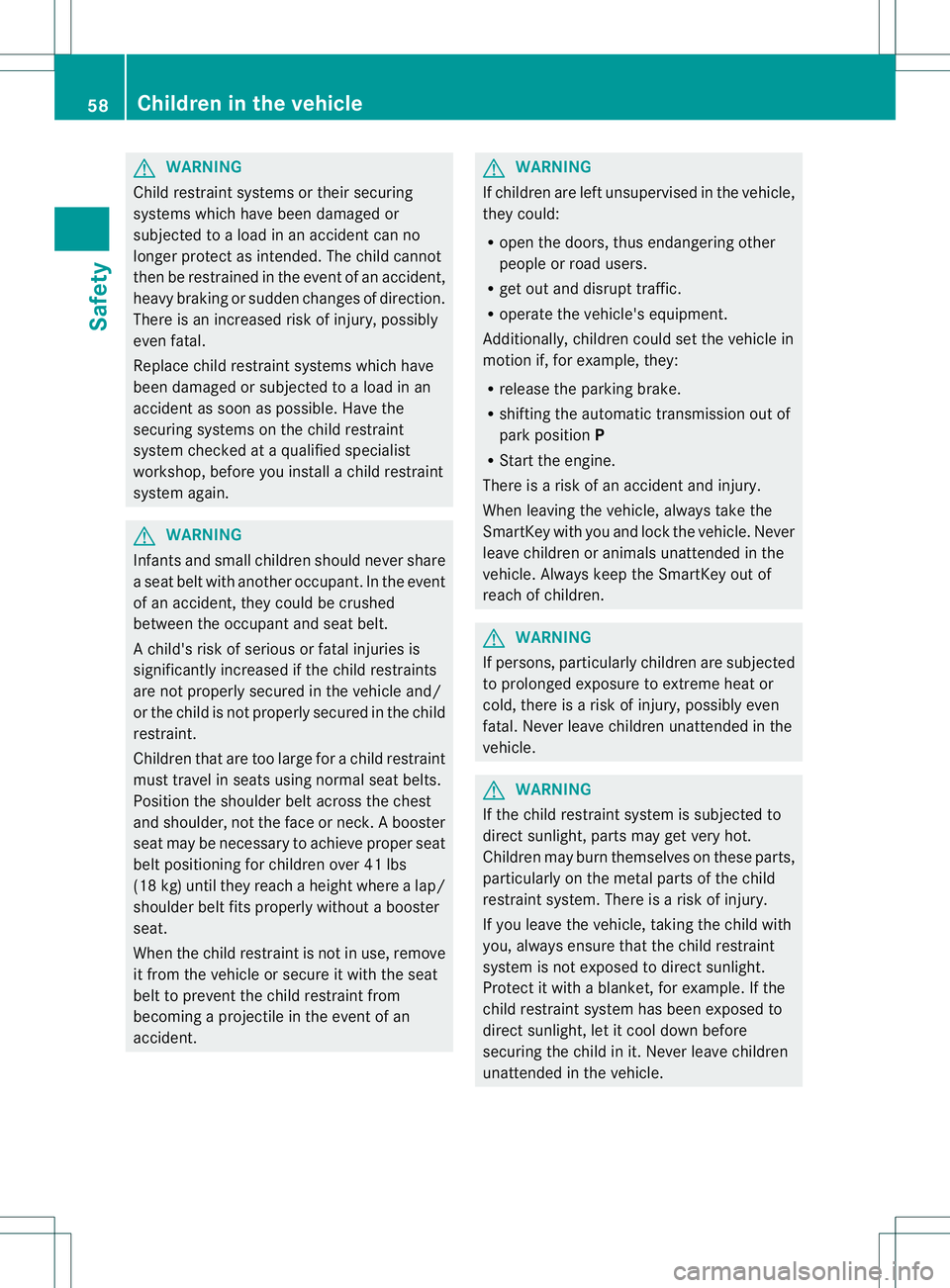
G
WARNING
Child restraint systems or their securing
systems which have been damaged or
subjected to aloa dinana ccident can no
longer protect as intended. The child cannot
then be restrained in the event of an accident,
heavy braking or sudden changes of direction.
There is an increased risk of injury ,possibly
even fatal.
Replace child restraint systems which have
been damaged or subjected to aloa dinan
accident as soon as possible.H ave the
securin gsystems on th echild restraint
system checked at aqualified specialist
workshop ,before you install achild restraint
system again. G
WARNING
Infants and small childre nshould never share
as eat belt with another occupant. In the event
of an accident, they could be crushed
between the occupant and seat belt.
Ac hild's risk of serious or fatal injuries is
significantly increased if the child restraints
are not properly secured in the vehicle and/
or the child is not properly secured in the child
restraint.
Children that are too large for achild restraint
must travel in seats using normal seat belts.
Position the shoulder belt across the chest
and shoulder, not the face or neck.Ab ooster
seat may be necessary to achieve proper seat
belt positioning for children over 41 lbs
(18 kg )until they reach aheight where alap/
shoulder belt fit sproperly without abooster
seat.
When th echild restraint is no tinuse, remove
it from the vehicle or secure it with the seat
belt to prevent the child restraint from
becoming aprojectile in the event of an
accident. G
WARNING
If children are left unsupervised in the vehicle,
they could:
R open the doors, thus endangering other
people or road users.
R get out and disrupt traffic.
R operate the vehicle's equipment.
Additionally, children could set the vehicle in
motion if, for example, they:
R release the parking brake.
R shifting the automatic transmission out of
park position P
R Start the engine.
There is arisk of an accident and injury.
When leaving the vehicle, always take the
SmartKey with you and lock the vehicle. Never
leave children or animals unattended in the
vehicle. Always keep the SmartKey out of
reach of children. G
WARNING
If persons, particularly children are subjected
to prolonged exposure to extreme heat or
cold, there is arisk of injury, possibly even
fatal. Never leave children unattended in the
vehicle. G
WARNING
If the child restraint system is subjected to
direct sunlight, parts may get very hot.
Children may burn themselves on these parts,
particularly on the metal parts of the child
restraint system. There is arisk of injury.
If you leave the vehicle, taking the child with
you, always ensure that the child restraint
system is not exposed to direct sunlight.
Protect it with ablanket, for example. If the
child restraint system has been exposed to
direct sunlight, let it cool down before
securing the child in it. Never leave children
unattended in the vehicle. 58
Children in the vehicleSafety
Page 63 of 360
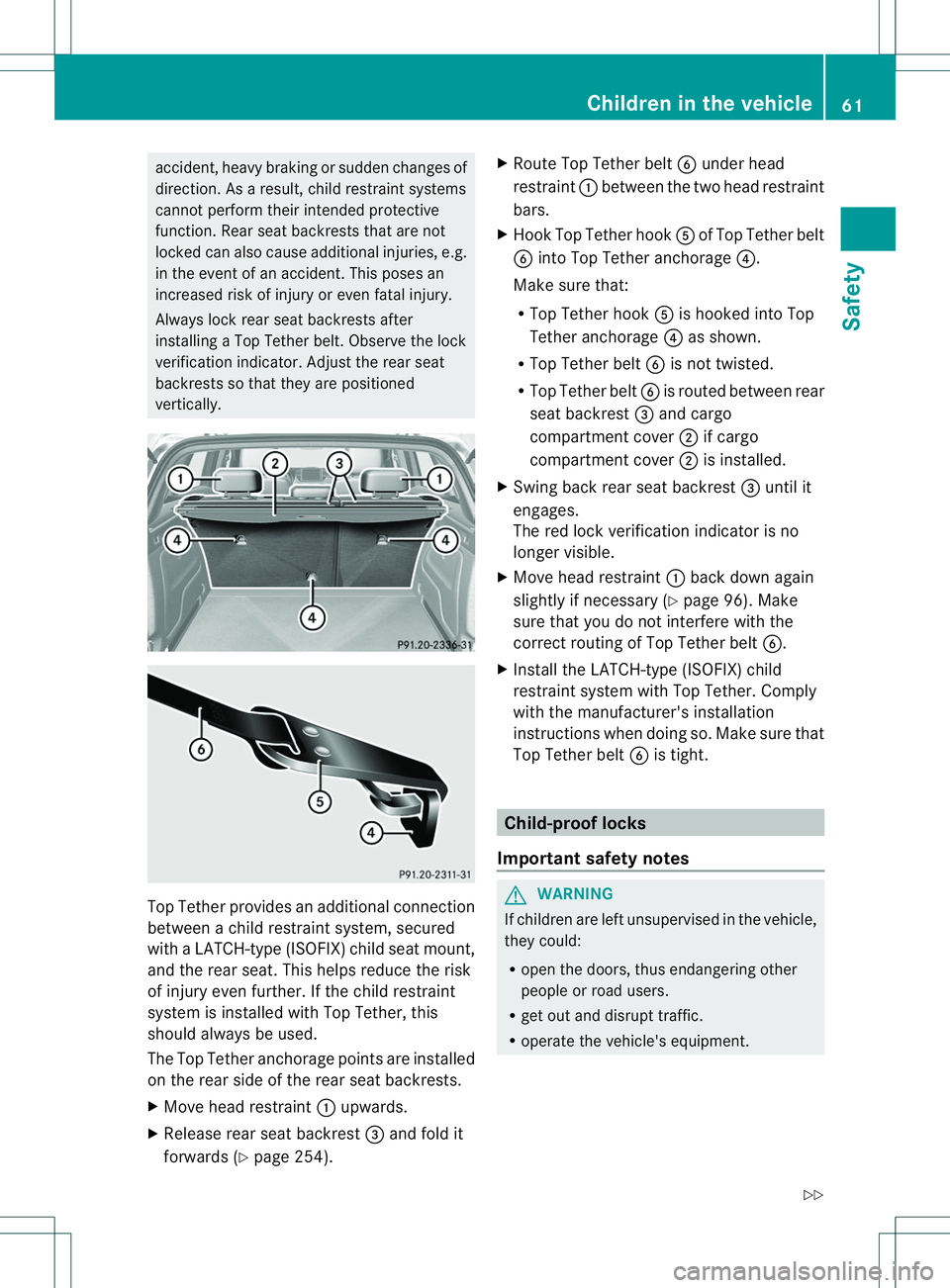
accident, heav
ybraking or sudden changes of
direction .Asaresult, child restraint systems
cannot perform their intended protective
function. Rear seat backrests that are not
locked can also cause additional injuries, e.g.
in the event of an accident. This poses an
increased risk of injury or even fatal injury.
Always lock rear seat backrests after
installing aTop Tether belt. Observe the lock
verification indicator. Adjust the rear seat
backrests so that they are positioned
vertically. Top Tether provides an additional connection
between achild restraint system, secured
with aLATCH-type (ISOFIX) child seat mount,
and the rear seat. This helps reduce the risk
of injury even further. If the child restraint
system is installed with Top Tether, this
should always be used.
The Top Tether anchorage points are installed
on the rear side of the rear seat backrests.
X Move head restraint 001Aupwards.
X Release rear seat backrest 0023and fold it
forwards (Y page 254). X
Route Top Tether belt 0024under head
restraint 001Abetween the two head restraint
bars.
X Hook Top Tether hook 001Eof Top Tether belt
0024 into Top Tether anchorage 0021.
Make sure that:
R Top Tether hook 001Eis hooked into Top
Tether anchorage 0021as shown.
R Top Tether belt 0024is not twisted.
R Top Tether belt 0024is routed between rear
seat backrest 0023and cargo
compartment cover 0010if cargo
compartment cover 0010is installed.
X Swing back rear seat backrest 0023until it
engages.
The red lock verification indicator is no
longer visible.
X Move head restraint 001Aback down again
slightly if necessary (Y page 96). Make
sure that you do not interfere with the
correct routing of Top Tether belt 0024.
X Install the LATCH-type (ISOFIX) child
restraint system with Top Tether. Comply
with the manufacturer's installation
instructions when doing so. Make sure that
Top Tether belt 0024is tight. Child-proof locks
Important safety notes G
WARNING
If children are left unsupervised in the vehicle,
they could:
R open the doors, thus endangering other
people or road users.
R get out and disrupt traffic.
R operate the vehicle's equipment. Children in the vehicle
61Safety
Z
Page 65 of 360

X
To activate/deactivate: press button001A.
If indicator lamp is lit, operatio nofthe rear
side windows is disabled. Operation is only
possible using the switches in the driver's
door. If the indicator lamp is off, operation
is possible using the switches in the rear
compartment. Driving safety systems
Overview of driving safety systems
In this section, you will find information about
the following driving safety systems:
R ABS ( Anti-lock BrakingSystem)
(Y page 70)
R BAS ( Brake Assist System) (Y page 64)
R COLLISION PREVENTION ASSIST (adaptive
Brake Assist and distance warning signal)
(Y page 64)
R Adaptive brake lights (Y page 67)
R ESP ®
(Electronic StabilityProgram)
(Y page 67)
R EBD ( Electronic Brake force Distribution)
(Y page 69)
R ADAPTIVE BRAKE (Y page 69)
(Y page 69)
R STEERC ONTROL (Y page 70) Important safety notes
If you fail to adapt your driving style or
become distracted, the driving safety
systems can neither reduce the risk of accident nor override the laws of physics.
Driving safety systems are merely aids
designed to assist driving. You are
responsible for the distance to the vehicle in
front,f
or vehicle speed and for braking in
good time. Always adapt your driving style to
suit the prevailing road, weather and traffic
conditionsa nd maintain asafe distanc efrom
th ev ehicle in front. Drive carefully.
i The driving safety systems describe donly
work as effectivel yaspossible when there
is adequat econtac tbetween th etires and
th er oad surface. Pay particular attention
to th einformatio nregarding tires,
recommended minimum tire tread depths
etc.int he "Wheels and tires" section
(Y page 312).
In wintry driving conditions, always use
winter tires (M+S tires) and if necessary,
snow chains. Only in this way will the
driving safety systems described in this
section work as effectively as possible. ABS (Anti-lockB
raking System)
General information ABS regulate
sbrake pressure in such away
tha tthe wheels do not lock when you brake.
This allowsy ou to continue steering the
vehicle when braking.
The 001C ABS warning lamp in the instrument
cluster lights up when the ignition is switched
on. It goes out when the engine is running.
Important safety notes i
Observe the "Important safety notes"
section for driving safety systems
(Y page 63). G
WARNING
If ABS is faulty, the wheels could lock when
braking. The steerability and braking
characteristics may be severely impaired.
Additionally, further driving safety systems Driving safety systems
63Safety
Z
Page 67 of 360

G
WARNING
The distance warning function cannot always
clearly identify objects and comple xtraffic
situations.
In such cases, the distance warning function
may:
R give an unnecessary warning
R not give awarning
There is arisk of an accident.
Always pay carefu lattention to the traffic
situation and do not rely solely on the distance
warning function.
Function
X To activate/deactivate: activate or
deactivate the distance warning function in
the on-board computer (Y page200).
Vehicles with amonochrome
multifunction display: when thedistance
warning function is activated, the 000E
symbo lappears in th estatus overview in the
multifunction display.
Vehicles with acolor multifunction
display:w hen the distance warning function
is deactivated, the 0002symbol appears in
the assistance graphic in the multifunction
display.
The distance warning function can help you
to minimize the risk of afront-end collision
with avehicle ahead or reduce the effectsof
such acollision. If the distance warning
function detectst hat there isarisk of a
collision, you will be warned visuallya nd
acoustically .Without your intervention, the
distanc ewarnin gfunction cannot prevent a
collision.
Starting at aspeed of aroun d4mph
(7 km/h), the distanc ewarnin gfunction
warns you if you rapidly approac havehicle in
front .Ani ntermitten twarnin gtonew ill then
sound, and the 0008distanc ewarnin glamp
will light up in the instrumen tcluster. X
Brake immediately in order to increase the
distanc efromt he vehicle in front.
or
X Take evasiv eaction provided it is safe to do
so.
Due to the nature of the system, particularly
complicated but non-critical driving
conditions may also cause the system to
display awarning.
With the help of the radar sensor system, the
distanc ewarnin gfunction can detect
obstacles that are in the path of your vehicle
for an extende dperiod of time.
Fro mas peed of aroun d40mph (70 km/h),
the distance warning function can also react
to stationary obstacles, such as stoppe dor
parked vehicles.
If you approach an obstacle and the distance
warning function detects arisk of acollision,
the system will initially alert you both visually
and acoustically.
In particular, the detectio nofobstacles can
be impaired if:
R dirt on the sensors or anythin gelse
covering the sensors
R snow or heavy rain
R interferenc ebyother radar sources
R ther eare strong radar reflections, for
example in parkin ggarages
R an arro wvehicle traveling in front, e.g. a
motorbike
R av ehicle traveling in fron tonadifferent line
relative to the center of your vehicle
Following damage to the fron tend of the
vehicle, have the configuratio nand operation
of the rada rsensor checked at aqualified
specialist workshop. This also applies to
collisions at low speeds where ther eisno
visible damage to the fron tofthe vehicle.
Adaptive Brake Assist i
Observe the "Important safety notes"
section for driving safety systems
(Y page 63). Driving safety systems
65Safety Z
Page 69 of 360
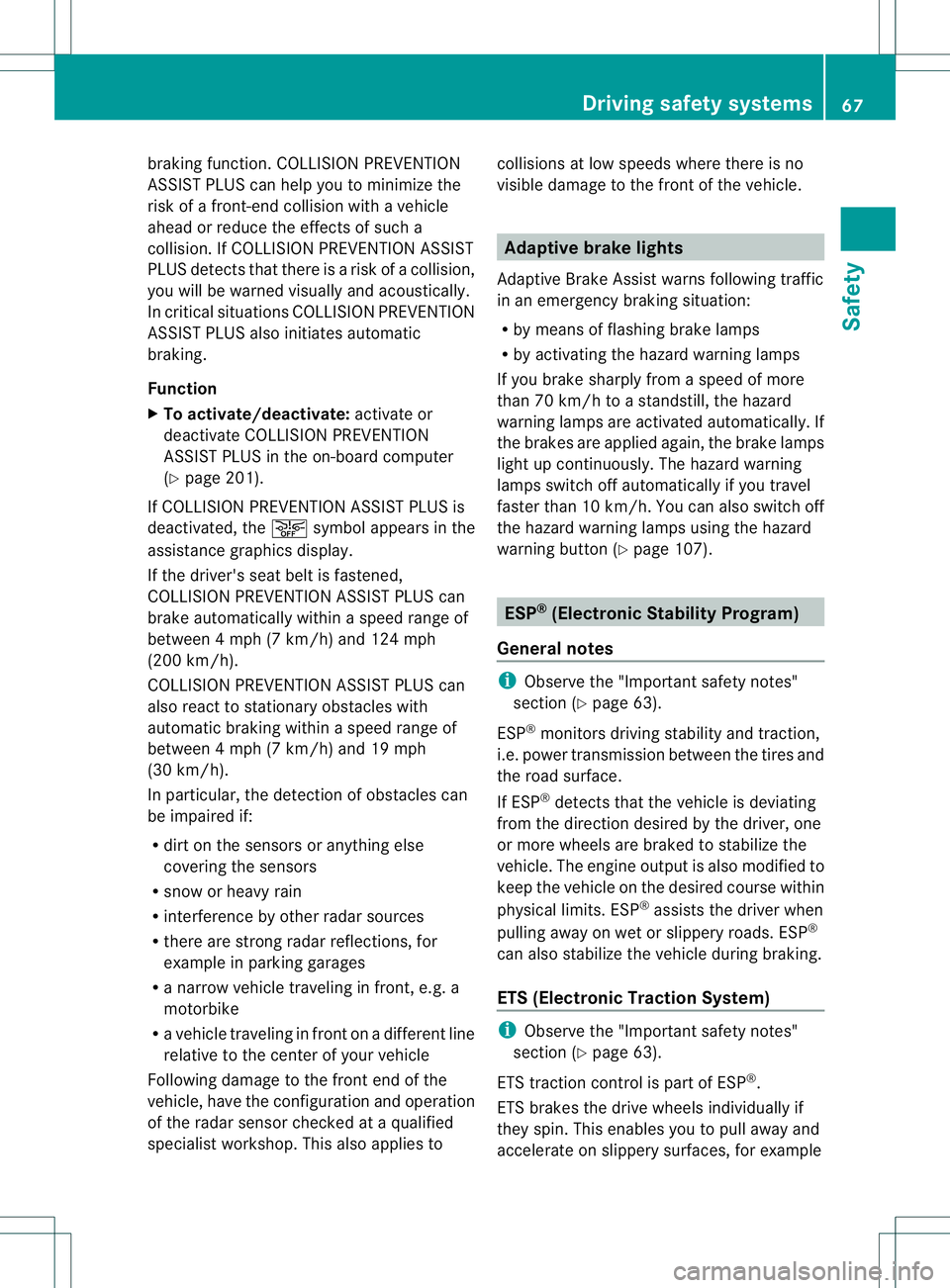
brakin
gfunction .COLLISION PREVENTION
ASSIS TPLUS can help you to minimiz ethe
risk of afront-end collision with avehicle
ahead or reduce the effects of such a
collision. If COLLISION PREVENTION ASSIST
PLUS detects that ther eisarisk ofacollision,
you will be warned visually and acoustically.
In critical situations COLLISION PREVENTION
ASSIST PLUS also initiates automatic
braking.
Function
X To activate/deactivate: activate or
deactivate COLLISION PREVENTION
ASSIST PLUS in the on-board computer
(Y page 201).
If COLLISION PREVENTION ASSIST PLUS is
deactivated, the 0002symbol appears in the
assistance graphics display.
If the driver's seat belt is fastened,
COLLISION PREVENTION ASSIST PLUS can
brake automaticallyw ithinaspeed range of
between 4mph (7 km/h) and 124 mph
(200 km/h).
COLLISION PREVENTION ASSIS TPLUS can
also react to stationary obstacle swith
automatic braking within aspeed range of
betwee n4mph (7 km/h) and 19 mph
(30 km/h).
In particular, the detection of obstacle scan
be impaired if:
R dirt on the sensors or anything else
covering the sensors
R snow or heavy rain
R interference by other radars ources
R there are strongr adar reflections, for
example in parking garages
R an arrow vehicle traveling in front,e .g. a
motorbike
R av ehicle traveling in front on adifferent line
relative to the center of your vehicle
Following damage to the front end of the
vehicle, have the configuration and operation
of the radar sensor checked at aqualified
specialist workshop. This also applies to collisions at low speeds where there is no
visible damage to the front of the vehicle. Adaptive brake lights
Adaptive Brake Assist warns following traffic
in an emergenc ybraking situation:
R by means of flashing brake lamps
R by activatin gthe hazard warning lamps
If you brake sharply from aspeed of more
than 70 km/ht oastandstill, the hazard
warning lamps are activated automatically. If
the brakes are applied again, the brake lamps
light up continuously. The hazard warning
lamps switch off automatically if you travel
faster than 10 km/h. You can also switchoff
the hazar dwarnin glamps using the hazard
warnin gbutton (Y page 107). ESP
®
(Electronic Stability Program)
General notes i
Observe the "Importan tsafet ynotes"
sectio n(Ypage 63).
ESP ®
monitors drivin gstability and traction,
i.e. power transmission between the tires and
the road surface.
If ESP ®
detects that the vehicle is deviating
from the direction desired by the driver, one
or more wheels are braked to stabilize the
vehicle. The engin eoutput is also modified to
keep the vehicle on the desired course within
physical limits. ESP ®
assists the driver when
pulling away on wet or slippery roads. ESP ®
can also stabilize the vehicle during braking.
ETS (Electronic Traction System) i
Observ ethe "Important safety notes"
section (Y page 63).
ETS traction contro lispart of ESP ®
.
ETS brakes the drive wheels individually if
they spin. This enables you to pull away and
accelerate on slippery surfaces ,for example Driving safet
ysystems
67Safety Z
Page 70 of 360
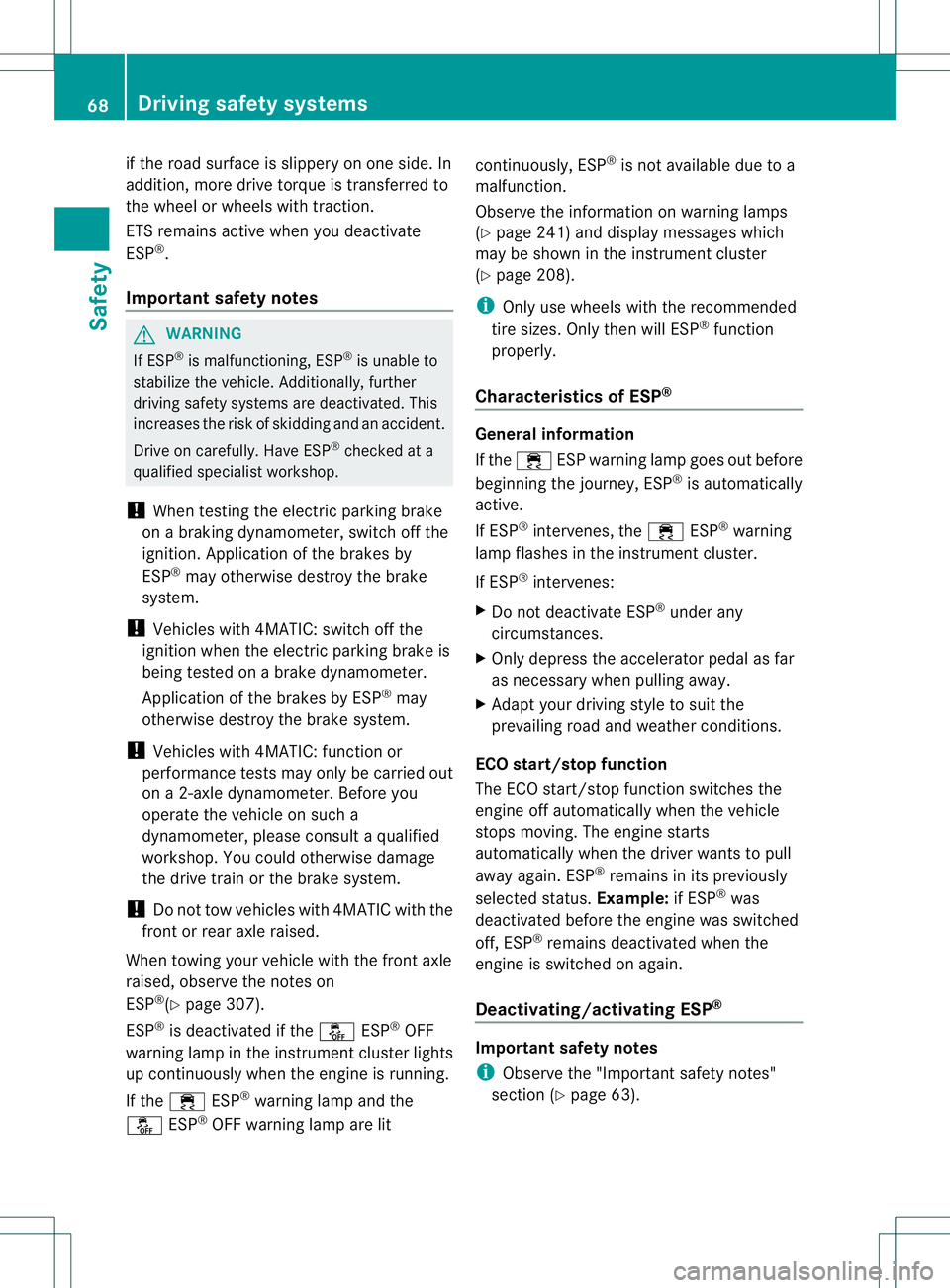
if the road surface is slipper
yono ne side. In
addition, mor edrive torque is transferre dto
the wheel or wheels with traction.
ETS remain sactive when you deactivate
ESP ®
.
Important safety notes G
WARNING
If ESP ®
is malfunctioning, ESP ®
is unable to
stabilize the vehicle. Additionally, further
drivin gsafet ysystems are deactivated. This
increases the risk of skidding and an accident.
Drive on carefully. Have ESP ®
checked at a
qualified specialist workshop.
! When testin gthe electric parking brake
on abraking dynamometer, switc hoff the
ignition. Application of the brakes by
ESP ®
may otherwise destroy the brake
system.
! Vehicles with 4MATIC: switc hoff the
ignition when the electric parking brak eis
being tested on abrak edynamometer.
Application of the brakes by ESP ®
may
otherwise destroy the brak esystem.
! Vehicles with 4MATIC: function or
performanc etests may only be carried out
on a2 -axle dynamometer. Before you
operat ethe vehicle on such a
dynamometer, please consult aqualified
workshop. You could otherwise damage
the drive train or the brak esystem.
! Do not tow vehicles with 4MATIC with the
front or rear axle raised.
When towin gyour vehicle with the front axle
raised, observe the notes on
ESP ®
(Y page 307).
ESP ®
is deactivated if the 0004ESP®
OFF
warnin glamp in the instrumen tcluste rlights
up continuously when the engine is running.
If the 000A ESP®
warnin glamp and the
0004 ESP®
OFF warnin glamp are lit continuously, ESP
®
is not available due to a
malfunction.
Observe the information on warnin glamps
(Y page 241 )and display messages which
may be shown in the instrumen tcluster
(Y page 208).
i Only use wheels with the recommended
tir es izes. Only the nwill ESP ®
function
properly.
Characteristics of ESP ® General information
If the
000A ESPw arnin glamp goes out before
beginnin gthe journey, ESP ®
is automatically
active.
If ESP ®
intervenes ,the 000A ESP®
warning
lamp flashes in the instrumen tcluster.
If ESP ®
intervenes:
X Do not deactivat eESP®
under any
circumstances.
X Only depres sthe accelerator pedal as far
as necessary when pulling away.
X Adapt your drivin gstyle to suit the
prevailing road and weathe rconditions.
ECO start/stop function
The ECO start/stop function switches the
engine off automatically when the vehicle
stops moving. The engine starts
automatically when the driver wants to pull
away again. ESP ®
remains in its previously
selected status. Example:if ESP®
was
deactivated before the engine was switched
off, ESP ®
remains deactivated when the
engine is switched on again.
Deactivating/activating ESP ® Important safety notes
i
Observe the "Important safety notes"
section (Y page 63). 68
Driving safety systemsSafety
Page 71 of 360
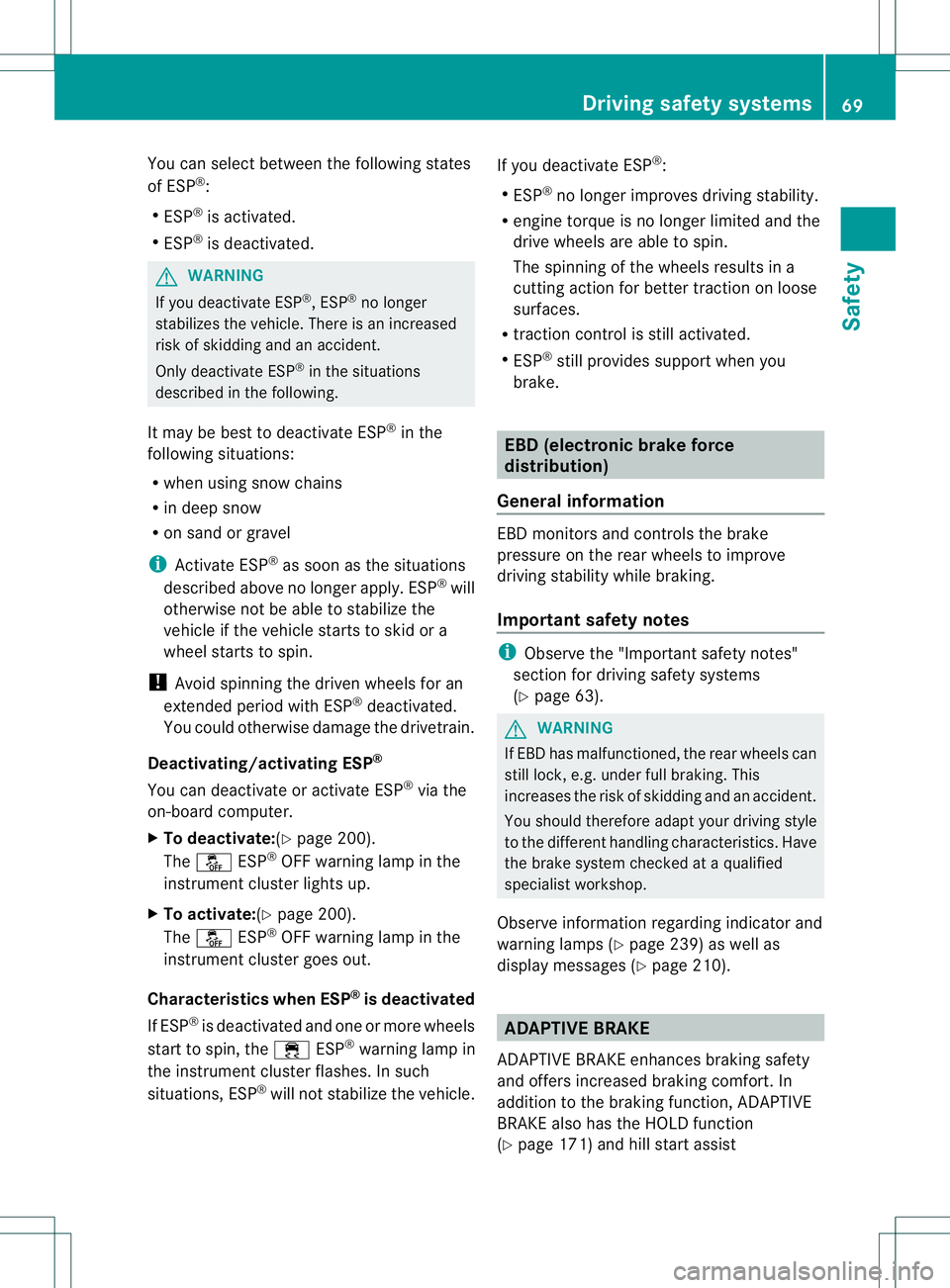
You can selec
tbetween the following states
of ESP ®
:
R ESP ®
is activated.
R ESP ®
is deactivated. G
WARNING
If you deactivat eESP®
,E SP ®
no longer
stabilizes the vehicle. There is an increased
risk of skidding and an accident.
Only deactivat eESP®
in the situations
described in the following.
It may be best to deactivat eESP®
in the
following situations:
R when using snow chains
R in deep snow
R on sand or gravel
i Activat eESP®
as soon as the situations
described above no longer apply. ESP ®
will
otherwise not be able to stabilize the
vehicle if the vehicle start stoskid or a
wheel start stospin.
! Avoid spinning the driven wheels for an
extended period with ESP ®
deactivated.
You could otherwise damage the drivetrain.
Deactivating/activating ESP ®
You can deactivat eoractivateESP®
via the
on-board computer.
X To deactivate:(Y page 200).
The 0004 ESP®
OFF warning lamp in the
instrument cluster lights up.
X To activate:(Y page 200).
The 0004 ESP®
OFF warning lamp in the
instrument cluster goes out.
Characteristics when ESP ®
is deactivated
If ESP ®
is deactivated and one or more wheels
start to spin, the 000AESP®
warning lamp in
the instrument cluster flashes. In such
situations, ESP ®
will not stabilize the vehicle. If you deactivat
eESP®
:
R ESP ®
no longer improves driving stability.
R engin etorque is no longer limited and the
drive wheels are able to spin.
The spinning of the wheels results in a
cutting action for better traction on loose
surfaces.
R traction control is still activated.
R ESP ®
still provides support when you
brake. EBD (electronic brak
eforce
distribution)
General information EBDm
onitors and controls the brake
pressure on the rear wheels to improve
driving stability while braking.
Important safet ynotes i
Observe the "Important safety notes"
section for driving safety systems
(Y page 63). G
WARNING
If EBDh as malfunctioned ,the rear wheels can
still lock, e.g .unde rfull braking .This
increases the risk of skidding and an accident.
You should therefore adapt your driving style
to the different handling characteristics. Have
the brake system checked at aqualified
specialist workshop.
Observe information regarding indicator and
warning lamps (Y page 239) as well as
displaym essages (Y page 210). ADAPTIVE BRAKE
ADAPTIVE BRAKE enhances braking safety
and offers increased braking comfort.In
addition to the braking function, ADAPTIVE
BRAKE also has the HOLD function
(Y page 171) and hill start assist Driving safety systems
69Safety Z